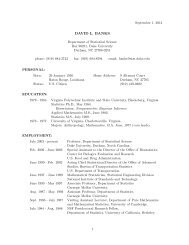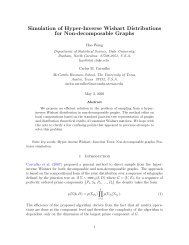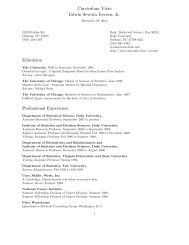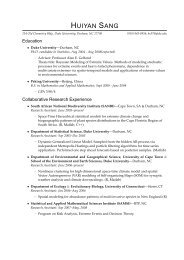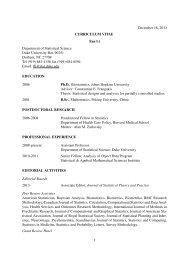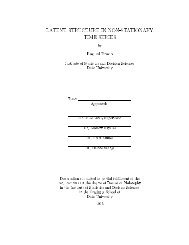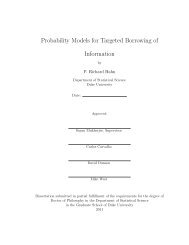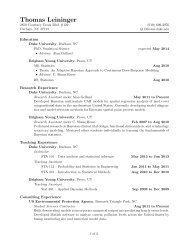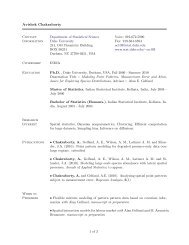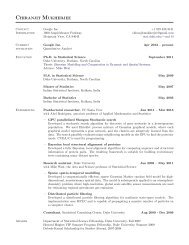Bayesian Dynamic Factor Models - Department of Statistical Science ...
Bayesian Dynamic Factor Models - Department of Statistical Science ...
Bayesian Dynamic Factor Models - Department of Statistical Science ...
You also want an ePaper? Increase the reach of your titles
YUMPU automatically turns print PDFs into web optimized ePapers that Google loves.
trajectories <strong>of</strong> posterior mean <strong>of</strong> several loadings also evidently change over time. Time-varying<br />
sparsity is observed for the loadings <strong>of</strong> JPY-<strong>Factor</strong>1, AUD-<strong>Factor</strong>3 and CHF-<strong>Factor</strong>3, with estimated<br />
values shrinking to zero for some time periods but not others, whereas other loadings such as<br />
CAD-<strong>Factor</strong>2 and -<strong>Factor</strong>3 are totally selected out over the entire time-frame.<br />
The interesting observation <strong>of</strong> the shrinkage pattern <strong>of</strong> JPY-<strong>Factor</strong>1 in 2008 implies that the JPY<br />
returns turned to be negatively correlated with <strong>Factor</strong>1. The loadings to <strong>Factor</strong>1 are all positive in<br />
the currencies except JPY. In 2008, the financial crisis led investors to reduce their size <strong>of</strong> US dollar<br />
short position and the currencies in our analysis except JPY depreciated against US dollar, whereas<br />
the JPY temporally appreciated.<br />
Figure 4 shows the proportion <strong>of</strong> variation <strong>of</strong> the time-series explained by each factor; the time<br />
variation <strong>of</strong> each factor’s contribution to the time-series is evident. By construction, <strong>Factor</strong>1 is a<br />
GBP-leading factor, although its explanatory ratio decreases from 2006 to 2009, and there are a<br />
few downward spots in the crisis period, which indicates an idiosyncratic variation <strong>of</strong> the GBP.<br />
<strong>Factor</strong>2 is recognized as an European factor that mainly explains the variation <strong>of</strong> EUR and CHF.<br />
The variation <strong>of</strong> JPY is <strong>of</strong> interest; the <strong>Factor</strong>1 primarily explains its fluctuation in 2006, but later<br />
its role is shifted to <strong>Factor</strong>3, namely a JPY-leading factor. A clear shrinkage <strong>of</strong> the contribution in<br />
JPY-<strong>Factor</strong>1, CAD-<strong>Factor</strong>2, and CAD-<strong>Factor</strong>3 is detected by the LTM structure as we observed in<br />
Figure 3. It would eliminate unnecessary fluctuation <strong>of</strong> the time-varying loadings and lead to an<br />
efficient distinction <strong>of</strong> the factors.<br />
Figure 5 plots the posterior estimates <strong>of</strong> the factors and their stochastic volatility. The trajec-<br />
tories and peak <strong>of</strong> the stochastic volatility remarkably differ among the factors. The stochastic<br />
volatility <strong>of</strong> <strong>Factor</strong>1 has the peak around September 2008 corresponding to the major crush <strong>of</strong> the<br />
market, whereas that <strong>of</strong> <strong>Factor</strong>2 has its peak around December 2008, when EUR and CHF returns<br />
exhibit relatively higher volatility in reaction to the US Senate’s rejection <strong>of</strong> the financial bailout<br />
for the automotive industry. The stochastic volatility <strong>of</strong> <strong>Factor</strong>1 exhibits a steeper hike towards the<br />
peak and a more moderate diminishing afterwards compared to that <strong>of</strong> <strong>Factor</strong>2.<br />
Figure 6 graphs posterior means <strong>of</strong> series-specific stochastic volatility, σit = exp(hit/2), that is,<br />
volatility elements excluding the common factors, exhibiting quite a different picture from Figure<br />
2. GBP has a unique hike <strong>of</strong> volatility in the second half <strong>of</strong> 2008 and CHF has several spikes in 2008<br />
and 2009, which are not explained by the factors. Because most <strong>of</strong> the fluctuation in EUR returns<br />
are explained by <strong>Factor</strong>1 and <strong>Factor</strong>2 as can be seen in Figure 4, the remaining series-specific shocks<br />
are relatively smaller than the others as shown in Figure 6.<br />
We determined the number <strong>of</strong> factors as k = 3 based on the forecasting performance, but also<br />
report experimental results from k = 4 factors case. As can be seen in Figure 7, the estimated<br />
trajectory <strong>of</strong> <strong>Factor</strong>4 is clearly shrunk with significantly smaller stochastic volatility than the other<br />
10






